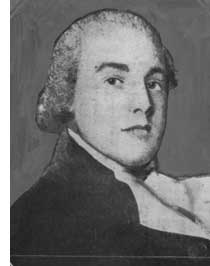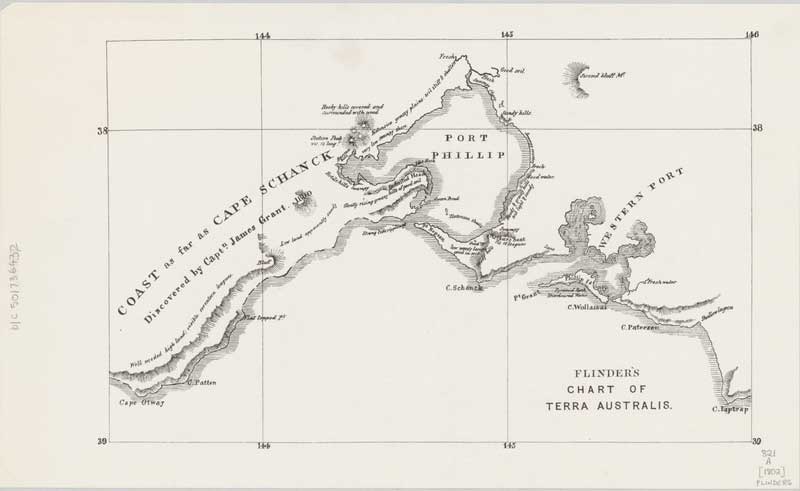
Wattamolla, Royal National Park, NSW
 George Bass (1771 - 1803) was a bold, intrepid character. Reports describe him as handsome, dark complexioned (he apparently wore glasses according to the description his father-in-law provided after George disappeared), and was six-feet tall. He was 'lively, strong minded, enterprising, well-humoured and physically very strong. He loathed inactivity and despised danger.
George Bass (1771 - 1803) was a bold, intrepid character. Reports describe him as handsome, dark complexioned (he apparently wore glasses according to the description his father-in-law provided after George disappeared), and was six-feet tall. He was 'lively, strong minded, enterprising, well-humoured and physically very strong. He loathed inactivity and despised danger. A naval officer at Port Jackson, New South Wales, described him as, a skillful navigator as well as a surgeon and physician. Governor Hunter remarked that George possessed a well-informed mind. Matthew Flinders, with whom George made major exploratory voyages described his friend as, a man whose ardour for discovery was not to be repressed by any obstacles nor deterred by any danger (Voyage to Terra Australis). George led an immensely active life. Although he trained as a surgeon he was fascinated by Naval exploration and the natural world. In his spare time he taught himself navigation and seamanship; how to splice and knot rope, how to navigate by sun, moon and stars, and how to use the Mercator and compass.
Throughout his career George travelled extensively in the southern oceans, but his major triumph came early in 1798 when he proved that New Holland (Australia) and Van Diemen's land (Tasmania) were in fact two separate land masses divided by a substantial channel. He was only twenty-eight years old. George's tenacity led to the naming of this channel by Governor John Hunter, The Bass Strait in honour of his achievement.
Since then the name of George Bass has been further honoured; The electorate of Bass (Tasmania), The Bass Highway, Bass River, Bass Isles, Point Bass and Venus Bay, named after the ship on which he disappeared in 1803.
George was born on 3rd February 1771 in Lincolnshire, England. His parents, George and Sarah, were farmers. In 1777 when George was 6, his father died, and mother and son (George was an only child) moved to Boston, a seaport, to live with relatives. It was here that George learned of the sea and ships and was introduced to books such as Captain Cook's Voyage Round The World, Don Quixote and Sinbad The Sailor. Sarah wanted George to become a Doctor - she was opposed to a career at sea - and she sent him to the local Grammar School, where he began to learn Latin, necessary for the job. Only 8 miles away in the town of Donnington another young boy, three years George's junior also had his sights on a life on the ocean waves. The boy was Matthew Flinders.
At the age of sixteen Sarah apprenticed George to Patrick Francis, a Boston Surgeon and Apothecary. two years George was given a diploma with honour and set off to London to qualify as a surgeon. From June to November of 1789 George served as Surgeon's mate on the HMS Flirt , a 14 gun sloop under the command of Captain James Norman. In 1790 George was assigned to the HMS Gorgon with the New South Wales Corps, bound for Botany Bay. However, the sailing was delayed and George did not embark for Australia until six years later. George returned to London where on 1st July 1790 he qualified as a second-rate Naval surgeon - he could now serve as surgeon on a second rate ship. From October 1790 to April 1794 Mr Bass served as surgeon on the HMS Shark and HMS Druid. On the 304 ton Shark, George was assisted by Thomas Thompson, and they attended 125 men under the command of the Hon. Arthur Kaye Legge. George received 90 pounds per annum.
Although war broke out between England and France whilst George was at sea, he was never involved in a confrontation. However, he was nearly shipwrecked off Cowes, England during fog (August 25 1791) and had a brush with an iceberg. It was on the Reliance that George met Matthew Flinders, who was Master's mate, and they discovered they shared identical desires. Flinders writes, 'I had the happiness to find....(in) this friend a determination was formed of completing the examination of the east coast of New South Wales' ('Voyage to Terra Australis'). In Deptford, England, George bought a small vessel, which he named The Tom Thumb, to be used for coastal exploration in the colony. The captain on the Reliance was Henry Waterhouse, who, five years later, became George's brother-in-law.
The Reliance set sail for Australia in January 1795. On board was Governor Hunter, returning to New South Wales after exhibiting Bennilong, an Aboriginal, to George III. Bennilong was homesick for Australia and became physically ill by the continuing delays in the ship's departure. Bennilong's spirit was broken and Hunter was 'doubtful of his living', but Mr Bass nursed him back to health during the voyage. Through Bennilong George came to learn something of Australia, and the indigenous people of the Port Jackson area. He even learned enough of the language to be able to converse by the time the Reliance reached Terra Australis. The Reliance, and convoy ship The Supply, reached Tenerife in early March. The two ships then proceeded to Rio de Janiero, where they were given a cold reception. From Brazil the Reliance headed straight for Australia and landed at Port Jackson on 7th September 1795.
On his arrival George found a colony of 3,000 people at Sydney Cove. Conditions of medical affairs were terrible. At Hawkesbury, surgery was being carried out by an unskilled convict! The mortality rate was high; 10% per annum of the colonial population were perishing, and smallpox had infected the Aboriginal people in 1789. However, George was more concerned with his exploratory research. Bass had been deeply influenced by the explorers Cook and Hunter, but he was also fascinated with the work of Naturalist Joseph Banks, president of The Royal Society back in England.
On arriving in Port Jackson, Flinders noted, 'It appeared that investigation of the coast had not been greatly extended beyond the three harbours (Botany Bay, Broken Bay and Port Jackson)'. George and Matthew were determined to explore the unchartered areas, but officials at Port Jackson regarded their quest as romantic rather than practical.
After seven weeks in the colony the fever of discovery was upon them and on 26th October 1795 Bass and Flinders, and loblolly boy Phillip Martin, sailed out through Sydney Heads into the Pacific Swell and then rowed up George's river. The explorers travelled twenty miles further than any previous expedition and Bass would often range in the woods studying new specimens whenever possible and noting soil and vegetation. On their return Bass and Flinders presented Governor Hunter with a report containing maps and sketches. Hunter was so impressed that he viewed the area for himself and established a new settlement - now called Bankstown.
In March 1796, Bass, Flinders and a boy named Martin set out in the new Tom Thumb. Built at port Jackson it was newer than the original but not any larger. The objective of their search was a large river, which both the natives spoke of south of Botany Bay and which Henry Hacking, quartermaster of HMS Sirius, has come across its upper reaches in the vicinity of Gymea Bay during a kangaroo hunting trip in the first year of the colony of NSW. Equipment for this expedition included ten days of supplies, two muskets plus ammunition. Fierce winds and strong currents carried them further south than they indended to go. After being swamped in attempting a landing in heavy surf, the party put into Tom Thumb Lagoon (now filled in to reclaim land for the Port Kembla Steelworks). Bass amused the natives by trimming their beards while the gunpowder dried.
On the return journey they were caught in a fierce storm. When hope of survival began to disappear, they were saved by entering a sheltered cove which they named Providential Cove at Wattamolla. Following the coast home, the next day they found not a big river but a large estuary of a small river, which they named Port Hacking after Henry Hacking. Their visit to the area is recognised in the naming of Bass and Flinders Point and a lookout there recording their visit.

Bass and Flinders Point, Cronulla, NSW
Discovery of fine country to the south-west of the colony in 1795 had delayed further attempts to push west across the Blue Mountains. George set out in June 1796 with two others. They took with them scaling irons and ropes to cope with the precipitous cliffs. They travelled on a southerly route into the lower Burragorang Valley and pushed west to a point just east of Kanangra Plateau but after 15 days during which they 'escaladed horrible perpendicular mountains' their provisions ran out and they were forced to return.
Having completed two successful voyages with Matthew Flinders, Bass was given command of an open whaleboat awith a crew of 6 sailors and 6 weeks' supply of food to explore the coast of New South Wales south of Sydney. He left Port Jackson in December, 1797, and followed the coast southwards, naming Shoalhaver River, Two Fold Bay and Furneaux Land (now Wilson's Promontory). He completed the detail omitted from Cook's chart and charted about 500 km of new coastline. Before reaching Western Port, he came across a party of 7 escaped convicts and promised to rescue them on his return. Rounding the south-east corner of the continent, he sailed into Western Port. His study of the currents, winds, and tides in this new area prompted him to suggest that Van Diemen's Land, as Tasmania was then known, was separated from the mainland by the strait which now bears his name. Strong winds forced him to stay here for nearly 2 weeks. He rescued the convicts on his way back and sailed back to Port Jackson.

Bass' last exploratory voyage, once again in company with Flinders, was to chart the coastline of Van Diemen's Land. Bass and Flinders convinced Governor Hunter that another expedition should be set up with a bigger boat and more men. In 1798, Bass and Flinders sailed the Norfolk through Bass Strait and round Van Diemen's Land (Tasmania), proving that it was an island. Bass returned to London in August 1800 and approached Henry Waterhouse, the captain of the Reliance, with a commercial shipping proposal. Waterhouse responded enthusiastically and with his entire revenue and the help of an Edinburgh merchant, Bass purchased a vessel, the Venus. Bass often visited Waterhouse to discuss the venture, but he also had an alterior motive; he had fallen in love with Waterhouse's sister, Elizabeth. The eldest of twelve children, Elizabeth was also three years Bass' senior.
Bass now faced a dilemma - it would be impossible to take Elizabeth on his travels so should he, could he, give up his life at sea and settle in London or the countryside as a surgeon? Bass put it to Elizabeth, who agreed to marry him if he promised to return to London immediately after the commercial venture. After less than three months of blissful marriage George set sail again on 21st December 1800. It was to be the last time that Bess and George would see each other.
Early in 1803, George prepared for his final voyage. He was bound for home (to England via South America with a cargo of contraband). Bass planned to leave via Dusky Bay, New Zealand where he evidently had plans to settle. He departed Port Jackson on the Venus on 5th February 1803, but was never seen again. Elizabeth would never give up hope that George was alive and well. She remained in London in order that she could immediately greet him on his return. There was a report in 1817 that George Bass was alive and trading in South America. It is not a wholly inconceivable idea; given that George had undertaken illegal dealings on that continent he may have felt it safer and more prudent to stay well out of the reach of the British Government. However, this report was never corroborated nor substantiated with any real evidence. George's deep affection for his wife and his excitement at the future enterprise in New Zealand would seem to discount the report. 21 long years spent waiting for her husband's return, Elizabeth died on 23rd June 1824.

Bass and Flinders Centre, George Town, Tasmania
Situated in George Town, Tasmania, is the Bass and Flinders Centre, a museum telling the story of British navigators Matthew Flinders and George Bass and their visit to the coasts of Tasmania. In 1798 they sailed around Tasmania in HM Colonial sloop Norfolk and proved it was an island. In 1998 the voyage was re-enacted with a replica Norfolk built out of Huon pine and Celery Top pine. Not a single nail or screw was used - all the joints are held together with tunnels. The replica is a major exhibit at the museum.




